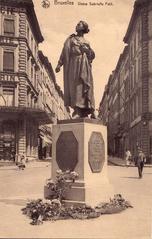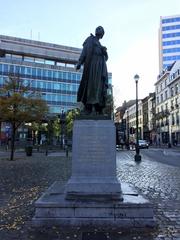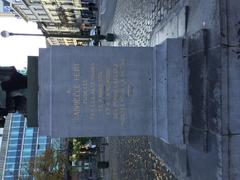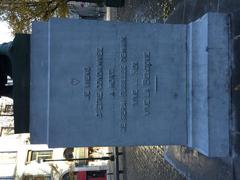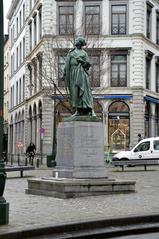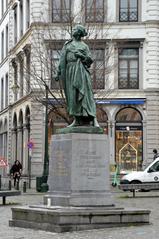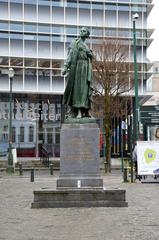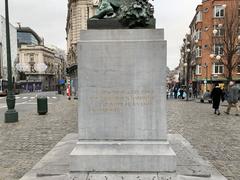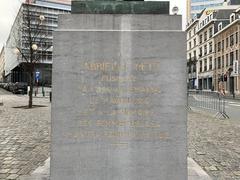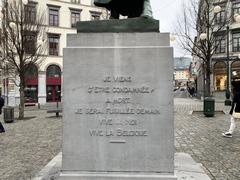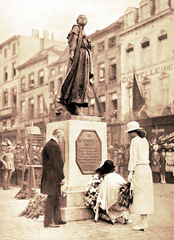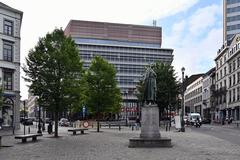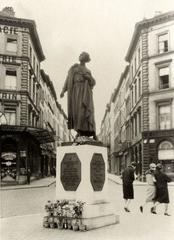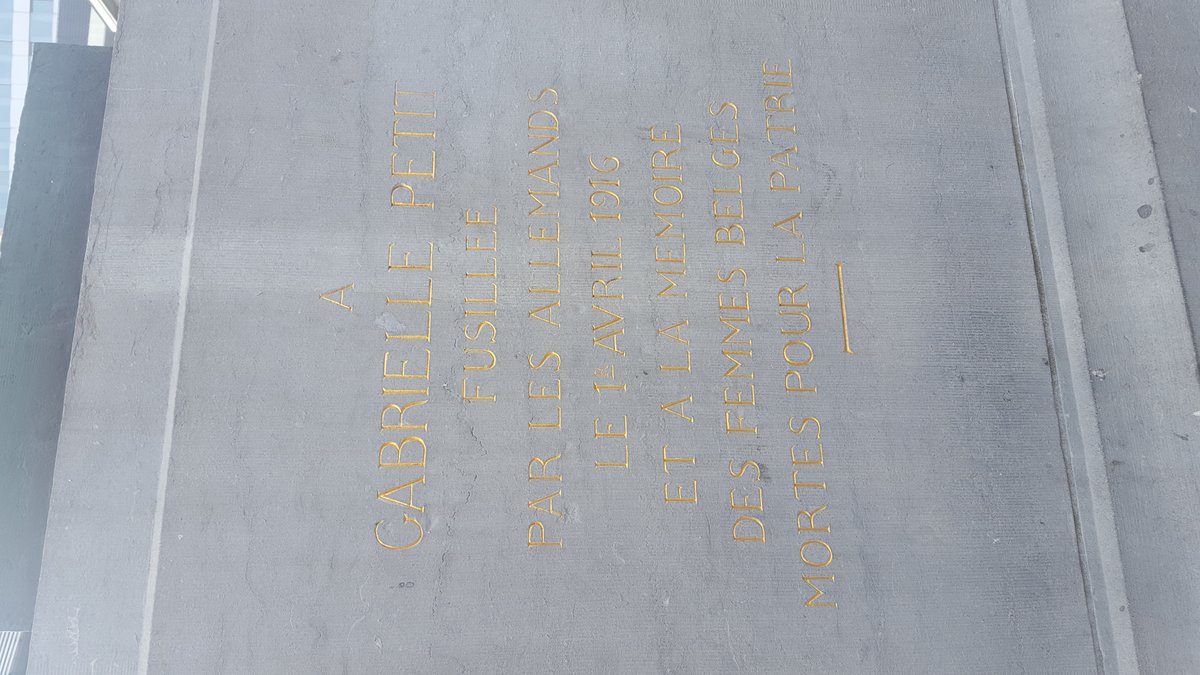
Gabrielle Petit Monument Visiting Hours, Tickets, and Guide to Brussels Historical Sites
Date: 14/06/2025
Introduction
The Monument Gabrielle Petit in Brussels is a powerful tribute to one of Belgium’s most celebrated heroines of World War I. Erected in 1923 at Place Saint-Jean, this monument honors Gabrielle Petit—a courageous working-class woman who became a symbol of resistance, patriotism, and the indispensable role women played during wartime. This comprehensive guide covers the monument’s historical significance, artistic features, visiting information, accessibility, and travel tips. Whether you are a history enthusiast, a cultural explorer, or a visitor seeking to connect with Brussels’ rich heritage, the Gabrielle Petit Monument is an essential destination.
(Wikipedia; Monument Heritage Brussels)
Table of Contents
- Historical Background
- The Monument: Artistic and Cultural Significance
- Visiting Information
- Cultural Importance and Events
- Frequently Asked Questions (FAQ)
- Conclusion
- References and Further Reading
Historical Background
Gabrielle Petit’s Life and Heroism
Gabrielle Petit was born in 1893 in Tournai, Belgium, to a working-class family. After her mother’s death, she was raised in a Catholic boarding school and later moved to Brussels as a young adult. At the outbreak of World War I, Petit volunteered for the Belgian Red Cross. Her courage and determination led to her recruitment by British intelligence, where she worked as a spy—gathering intelligence on German troop movements, distributing clandestine newspapers, and assisting Allied soldiers in escaping occupied Belgium.
Her tireless efforts and steadfast dedication made her an invaluable asset to the resistance, and she quickly rose to prominence within the network, operating at great personal risk throughout the German occupation. (Wikipedia; Atlas Obscura)
Arrest and Execution
In February 1916, Petit was betrayed by a German agent and arrested by German military police. She was imprisoned in Saint-Gilles Prison and faced a military tribunal. Despite being offered amnesty in exchange for betraying her network, she refused. On April 1, 1916, she was executed by firing squad at the Tir National in Schaerbeek at the age of 23. Her reported last words—“I will show them that a Belgian woman knows how to die. Long live the King! Long live Belgium!”—became a rallying cry for Belgian patriotism and marked her as a national martyr. (be-monumen.be)
Posthumous Recognition
Gabrielle Petit’s role in the resistance was kept secret during the war to protect other operatives. After the Armistice, her story became widely known. In 1919, Belgium honored her with a state funeral attended by the Queen, and her remains were reinterred at Schaerbeek Cemetery with full military honors. Her legacy is celebrated through books, films, annual commemorations, and the monument that bears her name. (Monument Heritage Brussels)
The Monument: Artistic and Cultural Significance
Creation and Symbolism
The Gabrielle Petit Monument was created by renowned Belgian sculptor Égide Rombaux and inaugurated in 1923. It is the first public statue in Belgium dedicated to a working-class woman and stands as a symbol of resistance, sacrifice, and the crucial contributions of women during wartime. The monument features a life-sized bronze statue of Petit, depicted standing defiantly, her gaze resolute—a testament to her courage.
The design purposefully avoids overt military symbolism, emphasizing the civilian role in resistance. Petit’s posture and expression embody both vulnerability and strength, while the document she holds references her work as a courier and spy. The statue is mounted on a blue stone pedestal, integrated into the vibrant urban landscape of Place Saint-Jean. (be-monumen.be)
Inscriptions and Memorialization
The pedestal bears multiple inscriptions:
- Front: “À Gabrielle Petit fusillée par les Allemands le 1er avril 1916 et à la mémoire des femmes belges mortes pour la patrie” (“To Gabrielle Petit, executed by the Germans on April 1, 1916, and to the memory of Belgian women who died for the homeland”).
- Sides: Quotes attributed to Petit, such as “Je viens d’être condamnée à mort, je serai fusillée demain. Vive le Roi, vive la Belgique” (“I have just been sentenced to death, I will be executed tomorrow. Long live the King, long live Belgium”) and “…et je leur montrerai comment une femme belge sait mourir” (“…and I will show them how a Belgian woman knows how to die”).
- Rear: Notes the monument was erected by national subscription at the initiative of the Ligue des Patriotes.
Visiting Information
Location and Accessibility
- Address: Place Saint-Jean, 1000 Brussels, Belgium
- Situated in the heart of Brussels, the monument is within walking distance of landmarks like the Grand Place and the Royal Galleries of Saint-Hubert.
- The square is flat and accessible to visitors with reduced mobility.
- Brussels has made significant improvements to accessibility, including adapted public transport and paved walkways. (visit.brussels)
Visiting Hours and Admission
- Visiting Hours: The monument is outdoors and accessible 24/7, year-round.
- Admission: Free of charge; no tickets required.
Getting There
- By Public Transport:
- Metro: Gare Centrale/Centraal Station (Lines 1 and 5), De Brouckère (Lines 1 and 5).
- Bus: Lines 48, 71, and 95 to Pl. Saint-Jean.
- Tram stops are also nearby.
- By Car: Paid parking is available at Parking 58 and Interparking, both within a 10-minute walk. (Evendo)
- Walking: The monument is easily accessible from major sites in Brussels’ historic center.
Nearby Attractions
- Grand Place: Iconic medieval square and UNESCO World Heritage Site.
- Royal Galleries of Saint-Hubert: Elegant shopping arcades with boutiques and cafés.
- Museum of the City of Brussels: Exhibits on the city’s rich heritage.
- Other Monuments: Manneken Pis, Everard t’Serclaes Monument, and more.
Travel Tips
- Visit during daylight hours for optimal visibility and safety.
- Early mornings or late afternoons offer the best lighting for photography and a quieter atmosphere.
- Combine your visit with a walking tour of Brussels’ historic core.
- Annual commemorative events are held on April 1st. Check local listings for details.
- For accessible travel information, consult the Handy.Brussels guide.
Cultural Importance and Events
The Gabrielle Petit Monument is a focal point for national remembrance and gender history. As the first public statue in Belgium dedicated to a working-class woman, it represents a significant step in recognizing the roles of women in wartime and civic life. The monument is regularly featured in educational tours, and annual ceremonies on April 1st draw veterans, officials, and citizens to honor Petit’s legacy.
It also serves as a rallying point for social causes, including women’s rights and civil liberties, reflecting its ongoing relevance in Belgian society. (Bloomsbury)
Frequently Asked Questions (FAQ)
Q: What are the visiting hours of the Gabrielle Petit Monument?
A: The monument is outdoors and accessible 24/7, with no official visiting hours.
Q: Is there an entry fee or ticket required?
A: No, visiting the monument is free of charge.
Q: How do I get there by public transport?
A: Use Metro lines 1 and 5 (Gare Centrale/Centraal Station or De Brouckère), or bus lines 48, 71, and 95 to Pl. Saint-Jean.
Q: Is the monument accessible for visitors with disabilities?
A: Yes, the area is wheelchair accessible, and nearby public transport is adapted.
Q: Are guided tours available?
A: The monument is included in several guided and self-guided walking tours of Brussels. Apps like GPSmyCity offer audio guides (GPSmyCity).
Q: Are there special events at the monument?
A: Annual commemorative ceremonies take place on April 1st.
Conclusion
The Gabrielle Petit Monument is an inspiring and accessible landmark, connecting visitors with a defining chapter of Belgian history. Its artistic merit, historical resonance, and central location make it a must-see for anyone exploring Brussels. Whether you seek to honor the past, appreciate public art, or learn about the vital role of women in resistance movements, the monument offers a profound and memorable experience.
For more information, plan your trip with Visit Brussels, and explore related resources for guided tours and upcoming events. Enhance your visit with the Audiala app, which provides audio guides and updates on Brussels historical sites.
References and Further Reading
- Wikipedia - Gabrielle Petit
- Monument Heritage Brussels
- be-monumen.be - Gabrielle Petit, Bruxelles
- Evendo - Statue of Gabrielle Petit
- Atlas Obscura - Gabrielle Petit Statue
- Visit Brussels
- Bloomsbury - Gabrielle Petit: The Death and Life of a Female Spy in the First World War
- Happy to Wander - Brussels Travel Tips
- GPSmyCity - Statue of Gabrielle Petit


